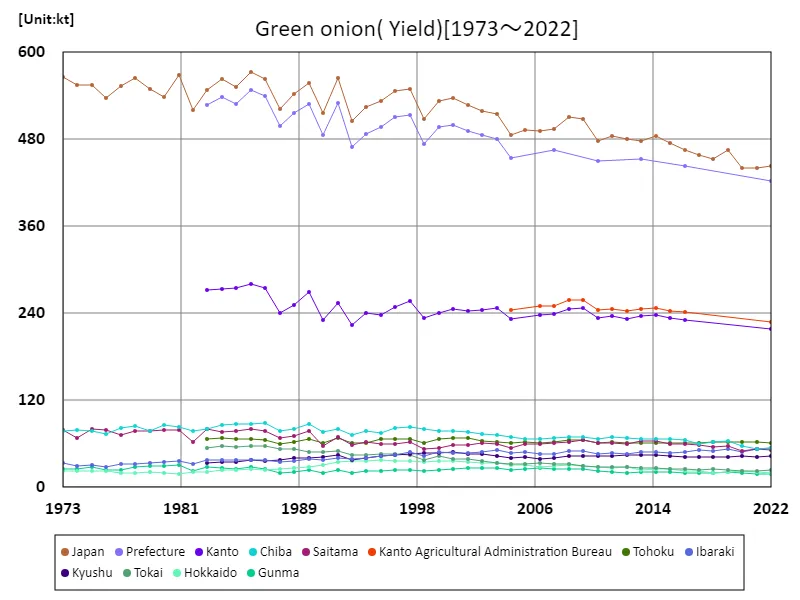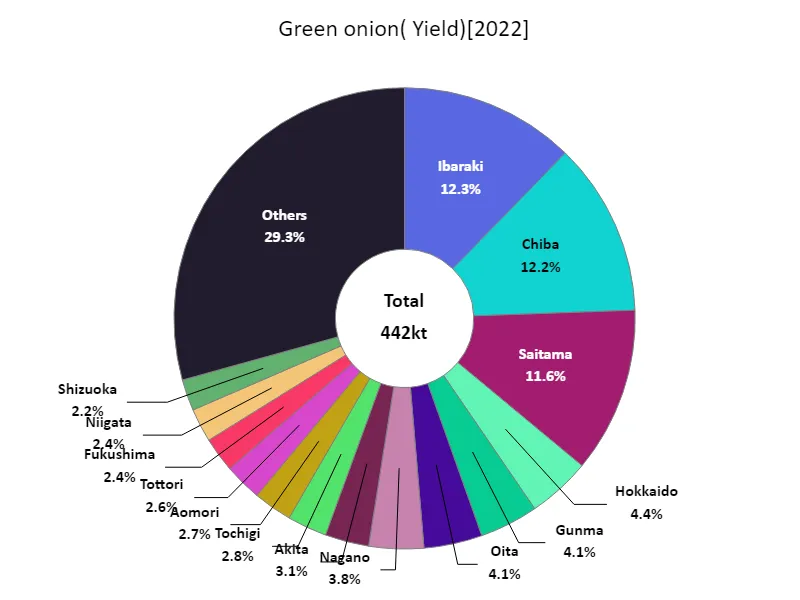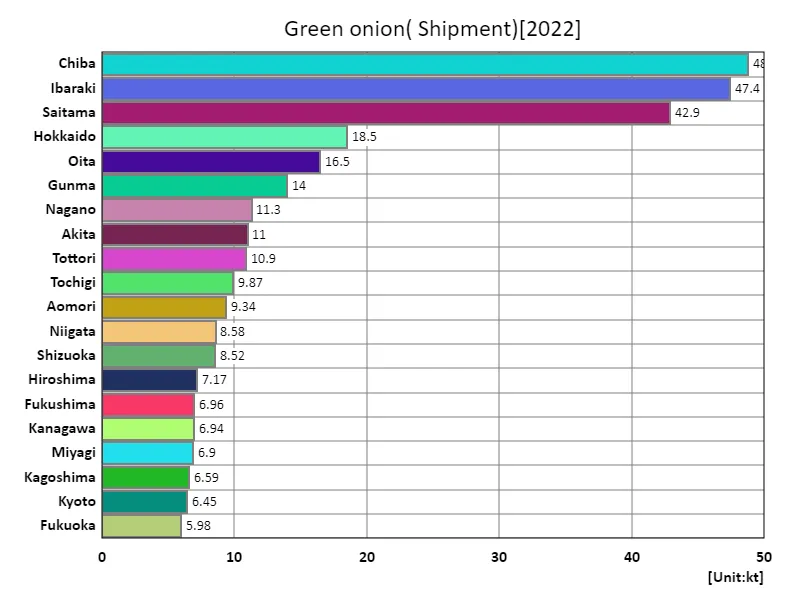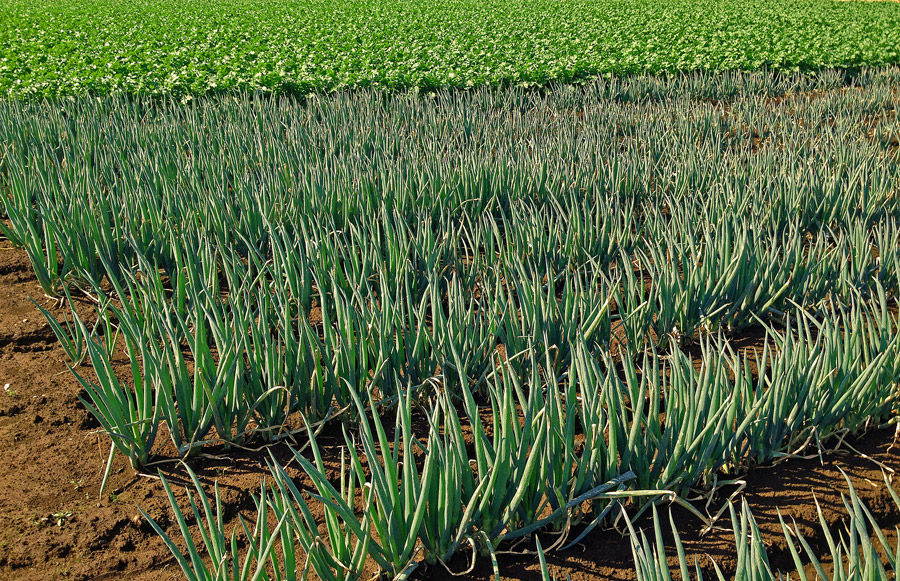Abstract
Looking at data on leafy vegetables in Japanese agriculture, especially onions, we can see that the national harvest volume in 2022 will be 443kt and the cultivated area will be 21.8kha. In contrast, Chiba Prefecture had the highest shipping volume at 48.8kt. The trends inferred from these data suggest high productivity, while the ratio of cultivated area to harvest yield indicates efficient production. Also, since the shipping volume is slightly lower than the harvest volume, it is possible that production is also taking place to meet domestic demand. Overall, it can be said that Japan’s leek agriculture has established an efficient and stable production system.
Onion harvest yield (main data).
Looking at data on Japanese onion harvests, we can see a number of changes between 1973 and 2022. At its peak in 1986, the national harvest reached 573kt, but has since gradually declined, with current harvest volumes standing at 77.2% of the peak. This change may be due to factors such as changes in agricultural policies and fluctuations in demand. Advances in agricultural technology and climate change are also thought to be affecting yields. On the other hand, the rate of decline from the peak has been gradual, suggesting stable demand. Past trends suggest that Japanese onion farming is growing sustainably by adapting flexibly to changes in demand and technological advances.


The maximum is 573kt[1986] of Japan, and the current value is about 77.2%
Onion harvest volume (by prefecture).
Looking at the data for leafy vegetable harvests in Japan by prefecture for 2022, Ibaraki Prefecture recorded the highest overall yield at 54.3kt. This surpasses previous records and demonstrates Ibaraki Prefecture’s leadership in leafy vegetable production. High production volumes are also seen in other regions, but Ibaraki Prefecture stands out. This characteristic may be due to climatic conditions, soil suitability, and advances in agricultural technology. Furthermore, there is high demand for leafy vegetables, and it is thought that producers in Ibaraki Prefecture are well prepared to meet this demand. In the future, it will be important for Ibaraki Prefecture and other production areas to maintain sustainable production systems while adapting to changes in demand and the environment.


The maximum is 54.3kt of Ibaraki, the average is 9.41kt, and the total is 442kt
Area cultivated with green onions (main data).
Looking at data on the area of land cultivated with onions in Japan, the peak of 25.3 kha nationwide was recorded in 1973. Since then, the area under cultivation has been on a downward trend, and is currently observed to be 86.2% of its peak area. Possible factors behind this downward trend include changes in agricultural policies, fluctuations in demand, and the progress of urbanization. Changes in land use and advances in agricultural techniques in areas where onions are produced may also be contributing factors. On the other hand, the rate of decline from the peak has been relatively gradual, suggesting that demand for green onions remains strong. In the future, it will be important to properly manage the reduction in the area of onions cultivated, while taking into account changes in demand and improvements in production efficiency, and to build a sustainable agricultural production system.


The maximum is 25.3kha[1973] of Japan, and the current value is about 86.2%
Area cultivated with green onions (by prefecture).
Looking at the data on the planted area of leafy vegetables in Japan in 2022, Saitama Prefecture recorded the highest area overall, at 2.12 kha. This exceeds previous records and indicates that Saitama Prefecture is a leading region for leafy vegetable production. Although relatively high cultivated areas can be seen in other regions as well, Saitama Prefecture stands out. This characteristic may be due to local climatic conditions, soil suitability, and advances in agricultural technology. It is also possible that there is high demand for leafy vegetables, and producers in Saitama Prefecture are well prepared to meet this demand. In the future, it will be important for production areas, including Saitama Prefecture, to maintain sustainable production systems while adapting to changes in demand and the environment.


The maximum is 2.12kha of Saitama, the average is 464ha, and the total is 21.8kha
The volume of green onions shipped.
Looking at the data for onion shipments in Japan in 2022, the highest overall was Chiba Prefecture at 48.8kt, with the average being 7.82kt. The overall total is 368kt. These figures suggest that Chiba Prefecture is a major region for green onion production. Chiba Prefecture’s shipping volume recorded the highest overall, indicating that onion production in the region is particularly active. Additionally, the overall average shipment volume was 7.82kt, suggesting that relatively stable production is also taking place in other regions. This suggests that the demand for green onions is stable and production is balanced in each region. In the future, it will be important for each region to maintain a sustainable production system while responding flexibly to changes in demand and climate conditions.


The maximum is 48.8kt of Chiba, the average is 7.82kt, and the total is 368kt



Comments